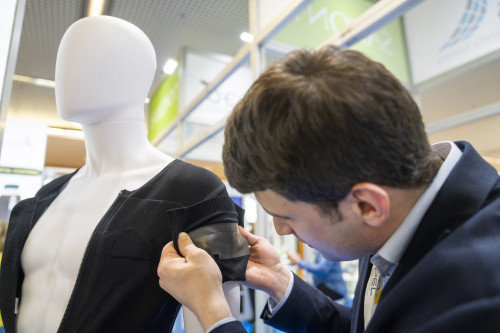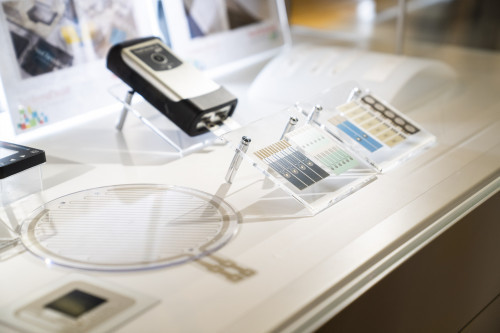Smart Living
The trade fair will showcase products and applications for printed electronics that are designed to make our everyday lives simpler, smarter and more environmentally friendly. These include a new generation of fitness trackers, 'intelligent' textiles and pharmaceutical packaging as well as self-adhesive solar films.
Mobility
Printed electronic components are opening up new opportunities and possibilities for the automotive and aviation industries. From sensors in passenger seats and electrochromic windows to ultra-flat touchscreens in the cockpit: numerous applications of printed electronics and 3D structural electronics are already in use today or are close to series production. For example, printed heating elements are becoming increasingly important in electric cars. As electric motors generate significantly less waste heat for heating than petrol and diesel engines, printed, lightweight and super-flat heating elements in the seats and behind door and side panels ensure pleasant temperatures inside the vehicle. An electrochromic layer printed on the back of the mirror or between flat panes of glass also enables infinitely variable color changes or opacity at the touch of a button or by automatic control. Another example: Interior and exterior mirrors in cars can automatically dim as soon as they are hit by bright light from other vehicles. In the case of windows, the driver determines the desired degree of tinting at the touch of a button. In airplanes, passengers can adjust the tinting of their windows from transparent to deep black - so if they either want to admire the clouds or prefer to doze off.
Design and haptics in the automotive sector
Printed electronics can be integrated into the curved surfaces of flexible touchscreens. The direct combination of design and electronic functionality through 3D structural electronics or in-mold electronics enables innovative human-machine interfaces while reducing weight and the number of components required. Mechanical switches can be replaced by tactile operating elements with haptic feedback. Organic light-emitting diodes (OLEDs) will increasingly be seen on the exterior of vehicles, as they can be printed on film, are extremely flexible and can be easily adapted to curved shapes.
Sustainability
The flexible, organic and printed electronics industry has moved to mass production. This goes hand in hand with an awareness of the responsibility that production and use have for the climate and environment. LOPEC is therefore dedicated to the production processes and the basic technology, also from the point of view of sustainability. PE printing processes are very energy-efficient compared to conventional production processes. Less material is used in the additive printing process and the amount of waste that needs to be disposed of or treated is greatly reduced. The materials used are often organic chemicals that are harmless to the environment and improve recycling. During production, printed electronics save material and reduce the weight of a product. Among other things, this can help to avoid food waste, reduce fuel consumption or generate clean electricity.




